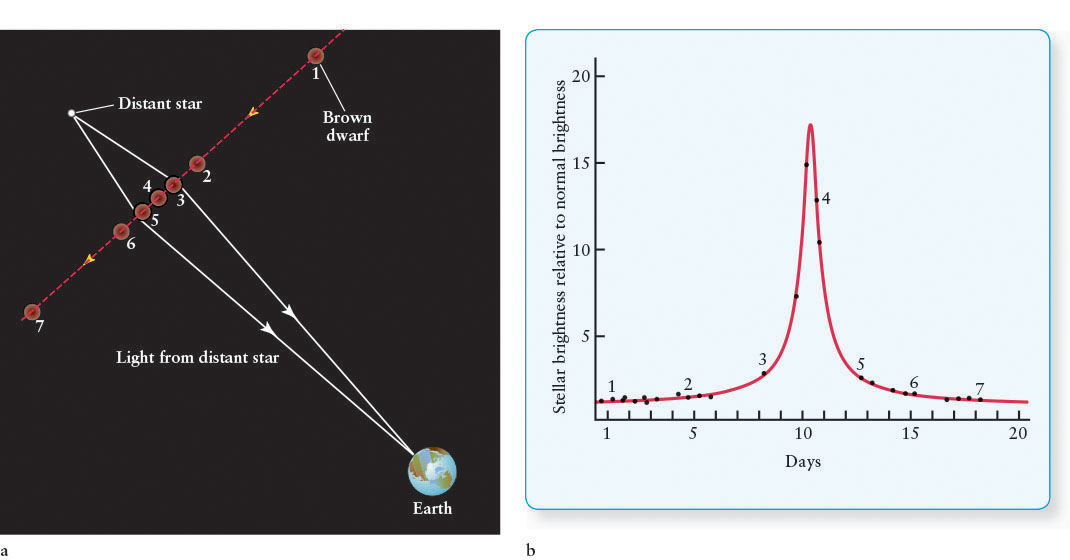Mysteries at The Galactic Fringes
Because the band of the Milky Way extends all around Earth, we know that stars and other matter exist beyond the Sun’s orbit. In recent years, astronomers have been astonished to discover just how much matter lies farther from the center of our Galaxy than we are.
15-7 Most of the matter in the Galaxy has not yet been identified
According to Kepler’s third law, out beyond the bulk of the Galaxy’s visible disk, the orbital speeds of stars should decrease with distance from the Galaxy’s center (see the dashed line in Figure 15-19), just as the orbital speeds of the planets decrease with increasing distance from the Sun (which contains the bulk of the solar system’s mass). Observations reveal, however, that galactic orbital speeds continue to climb well beyond the visible edge of the galactic disk. Thus, there must be more gravitational force from the Galaxy acting on the distant stars and clouds than we can see or have taken into account.
These observations led astronomers to calculate that a surprising amount of matter must lie beyond the bulk of the visible matter (that is, the stars, gas, and dust) in the Galaxy. Nearly 90% of the mass of our Galaxy has yet to be located. If we include the mass of the as-yet-unidentified matter, the Milky Way’s total mass must be around 1.2 × 1012 M⊙.
To make matters even more mysterious, much of this mass is in the form of dark matter: Whatever it is, very little of it shows up on images at any wavelength. Given its gravitational effect on the stars and gas in the Galaxy that we can detect, astronomers deduce that this dark matter is spherically distributed all around the Galaxy in a massive halo extending at least 12 times farther from the galactic nucleus than we are, far beyond the halo defined by the visible globular clusters and halo field stars (see inset in Figure 15-11). Small fractions of the dark matter are composed of neutrinos and white dwarfs, but the nature of the rest of it—whether black holes, gas, Jupiterlike bodies, brown dwarfs, or something far more exotic—has yet to be determined. The unidentified matter in our Galaxy is sometimes called the missing mass. This is a poor name because the matter is not missing; we just do not yet know its nature.
Some searches for dark matter rely on the principle from general relativity that matter causes passing light to change direction (see Figure 14-5). The Galaxy’s dark matter may contain relatively massive objects, like brown dwarfs or black holes. If so, these objects will cause the light from more distant stars to change direction as the dark objects pass between those stars and Earth (Figure 15-20a). Such objects are called MACHOs (massive compact halo objects). Indeed, as a dark object moves directly between a more distant star and Earth, the star’s light is focused toward us, causing the star to brighten. Called microlensing, this brightening of distant stars for several weeks has been observed (Figure 15-20b). Microlensing observations indicate that only a small fraction of the Galaxy’s dark matter is in the form of these MACHOs.

15-8 Frontiers yet to be discovered
Despite our being part of it, our knowledge of the Milky Way is limited by the difficulty in making observations through its gas and dust. We have yet to locate all of the globular clusters. Even more challenging will be locating and categorizing all of the stars and clouds of gas and dust in the disk of the Galaxy. Are there any more small galaxies that the Milky Way is consuming? We also have to determine fully and accurately the structure and extent of the spiral arms and the bar of gas, dust, and stars running through the central bulge.
477
Our observations of the Galaxy’s nucleus hint at its remarkable activity that has yet to be explained. What is heating the 100-million-K gas? What is creating the positrons there, whose resulting gamma rays we observe? In its farthest reaches, what else is in the Galaxy’s halo that creates all of the gravitational force we detect, but whose source is not yet observed? In other words, what is the dark matter? Another major unsolved mystery is the formation process of our Galaxy. Did stars form first? Did the supermassive black hole form and then pull gas and dust into orbit, which then formed stars? Did smaller galaxies form and then coalesce into the Milky Way as it is today? Astronomers are presently working to answer all of these questions.